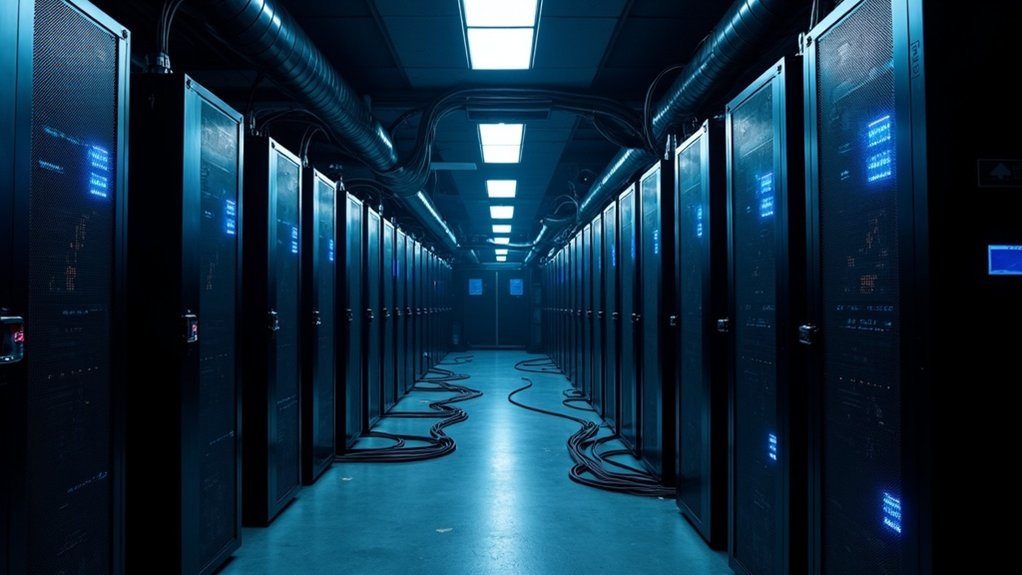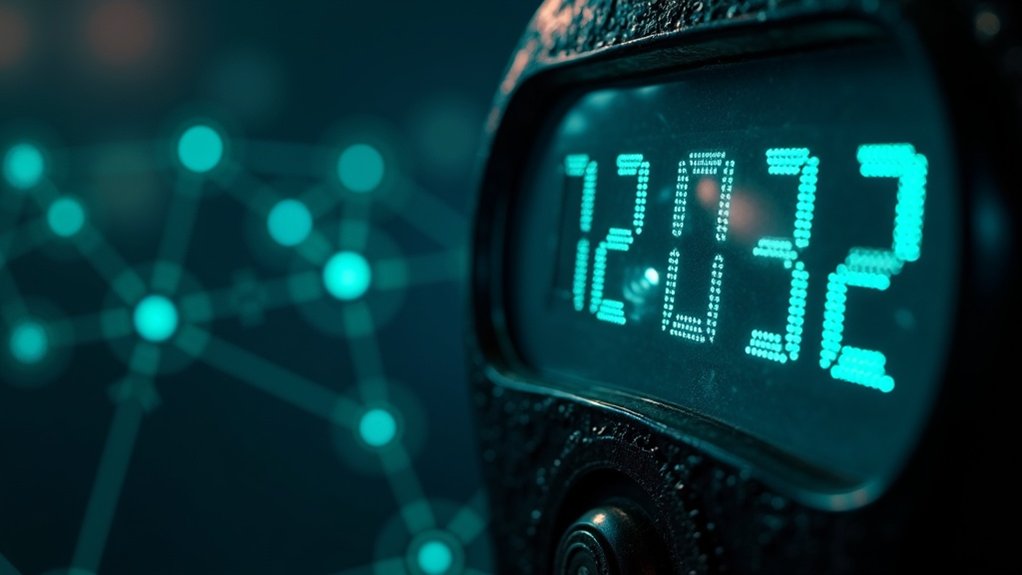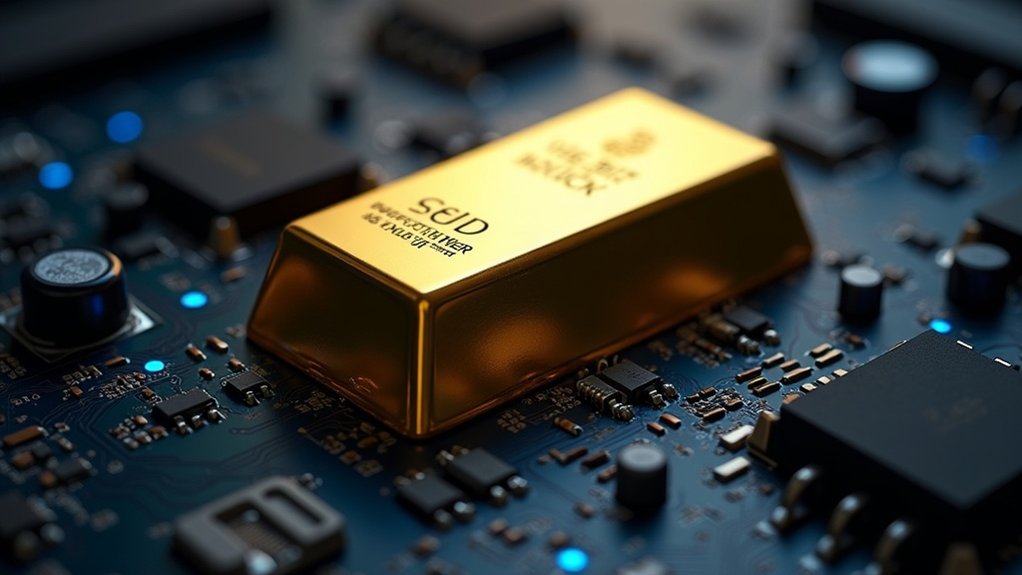Crypto miners validate transactions and add them to the blockchain ledger. They’re digital accountants with supercomputers, preventing fraud in decentralized networks. Using specialized hardware, miners solve complex puzzles through the SHA-256 hashing function, repeatedly guessing a “nonce” until they find a valid block hash. For their trouble, they earn newly minted cryptocurrency and transaction fees. The system adjusts puzzle difficulty automatically every 2,016 blocks to maintain consistency. The mining game isn’t for the faint of wallet or weak of processor.
While most people think cryptocurrency appears out of thin air, it’s actually created through a complex process called mining. This digital treasure hunt involves validating transactions and adding them to a blockchain ledger.
Miners are fundamentally accountants with supercomputers, making sure nobody’s cheating the system. They’re the backbone of decentralized networks like Bitcoin. Without them, the whole system would collapse. Simple as that. Similar to how bounty airdrops reward participants for specific tasks, miners earn rewards for their work.
So what exactly do these miners do all day? They group pending transactions into blocks and then solve cryptographic puzzles—basically complex math problems that computers are good at but humans aren’t. Using the SHA-256 hashing function for Bitcoin, miners repeatedly guess a magic number called a nonce.
It’s mind-numbingly repetitive work. Find the right nonce, create a valid block hash, and boom—you’ve mined a block.
The hardware isn’t your average laptop. Miners use specialized equipment like ASICs or GPUs that cost thousands. These machines run hot—really hot. They consume electricity like a small country. Efficiency matters.
Hash rate (calculations per second) determines success. More hash power? Better chance of winning the mining lottery. Mining pools combine the computational resources of multiple miners to increase the chances of solving puzzles and earning Bitcoin rewards collectively.
The network automatically adjusts puzzle difficulty every 2,016 blocks. More miners join? Puzzles get harder. Fewer miners? Easier puzzles. This keeps blocks coming roughly every 10 minutes. It’s an elegant self-correcting system. No human intervention required.
The payoff? Miners receive newly minted cryptocurrency plus transaction fees. Successful miners currently earn 3.125 Bitcoin per block as a reward for their computational efforts. It’s a sweet deal, or at least it was. Block rewards halve periodically—Bitcoin’s famous “halvings.” What once was 50 BTC per block is now just 6.25.
Eventually, transaction fees will become the primary incentive.
Mining isn’t for everyone. It’s competitive, technical, and expensive. But for those who crack the code, it can be profitable. That’s why massive mining farms exist worldwide. They’re not doing this for fun. They’re doing it for the money.
Frequently Asked Questions
How Much Electricity Does Crypto Mining Consume?
Bitcoin mining guzzles electricity at an alarming rate. The network consumed about 173 terawatt-hours annually in 2025—that’s 0.5% of global electricity demand.
We’re talking about power equivalent to entire countries like Finland or Australia. A single Bitcoin transaction? A whopping 1,335 kilowatt-hours, what an average US home uses in 45 days.
Despite 54% now coming from renewables, the absolute consumption remains massive. The numbers are, quite frankly, staggering.
Can I Mine Cryptocurrency on My Smartphone?
Yes, but it’s a terrible idea.
Smartphones lack the processing power for profitable mining. They overheat, drain battery life rapidly, and might get damaged. The electricity cost to charge the phone exceeds any mining rewards.
Most apps are either cloud-based (requiring investment) or inefficient at best, scams at worst. Apple and Google ban many mining apps anyway.
For serious mining, smartphones are basically useless. Nice try, though.
Are Some Cryptocurrencies Easier to Mine Than Others?
Yes, cryptocurrencies vary dramatically in mining difficulty.
Bitcoin? Nearly impossible for individuals now. Network competition and sky-high difficulty levels have seen to that.
Meanwhile, newer or less popular coins have lower difficulty barriers. ASIC-resistant currencies like Ravencoin can be mined with regular GPUs, while Bitcoin requires specialized hardware.
The algorithm matters too. Memory-hard algorithms favor casual miners with standard equipment.
It’s basically economics – less competition equals easier mining. Simple as that.
How Do Mining Pools Split Rewards?
Mining pools split rewards using several methods.
Pay-per-Share (PPS) offers fixed payments per valid share regardless of block success.
PPLNS rewards based on recent contributions, discouraging pool-hopping.
Proportional systems divide rewards based on shares submitted during a round.
Each method balances risk differently.
PPS? Stable income but higher fees.
PPLNS? Loyalty pays off. The pool takes its cut, miners get the rest.
Bottom line: different pools, different rules. Miners choose their poison.
Is Mining Still Profitable With Market Volatility?
Mining profitability amid volatility? It’s complicated.
Bull markets make mining lucrative; bear markets crush margins. Large operations with cheap electricity and cutting-edge hardware still turn profits. Small miners? They’re getting squeezed.
The 2024 Bitcoin halving didn’t help. Rewards dropped to 3.125 BTC per block. Ouch.
Some miners survive by targeting altcoins or joining pools. Others bet on long-term price appreciation rather than immediate returns.
Bottom line: volatility separates the professionals from the hobbyists. Always has.









